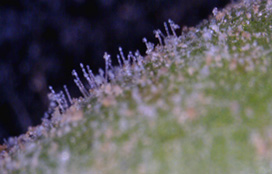February is a month when powdery mildew can make its initial appearance in maturing
lettuce plantings. The disease, caused by the fungus
Golovinomyces cichoracearum,
is first observed as very small spots of white fungal growth on both upper and lower
leaf surfaces of the oldest leaves. From these initial infection sites, the fungus
continues to grow on the leaf surface and release vast quantities of spores which
are carried in the air, and upon landing on lettuce leaves initiate additional infections
under favorable temperature and moisture conditions. The most favorable temperature
range for spore germination is 65 to 77 °F. Relative humidity at or above 85% is
required for infection, growth and sporulation by the pathogen; however, free moisture
will actually kill powdery mildew spores. Low light intensity also favors powdery
mildew development. These requirements are often all met for several hours daily,
especially on lettuce leaves near or at the soil surface in a maturing lettuce planting.
As little as 4 days are needed from infection to production of a new crop of pathogen
spores. Depending on environmental conditions and the particular susceptibility
of the lettuce variety being grown, preventative applications of a fungicide may
be needed to prevent economic loss to the crop. The oldest leaves containing the
first powdery mildew infection sites will not be harvested; however, these leaves
serve as nurseries for production and release of spores, which can infect the marketable
portion of the lettuce plant. In recent field trials conducted at the Yuma Agricultural
Center, fungicides that provided excellent control of powdery mildew on lettuce
included Fontelis (penthiopyrad), Merivon (fluxapyroxad+pyraclostrobin), Microthiol
Disperss (wettable sulfur), Procure (triflumizole), Quintec (quinoxyfen), and Rally
(myclobutanil). Initiating fungicide treatments before or at the very latest at
the very first sign of infection on the oldest leaves will result in the best levels
of disease control.
Click picture to listen to Mike's update




